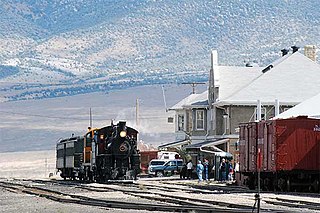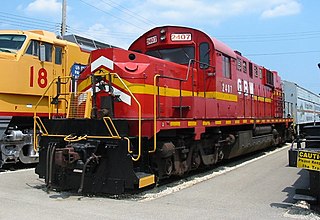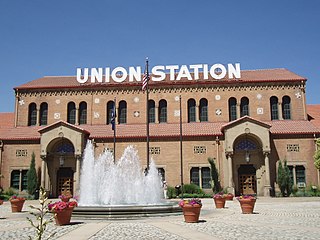
The St. Louis–San Francisco Railway, also known as the "Frisco", was a railroad that operated in the Midwest and South Central United States from 1876 to April 17, 1980. At the end of 1970, it operated 4,547 miles (7,318 km) of road on 6,574 miles (10,580 km) of track, not including subsidiaries Quanah, Acme and Pacific Railway and the Alabama, Tennessee and Northern Railroad; that year, it reported 12,795 million ton-miles of revenue freight and no passengers. It was purchased and absorbed into the Burlington Northern Railroad in 1980. Despite its name, it never came close to San Francisco.

The Nevada Northern Railway Museum is a railroad museum and heritage railroad located in Ely, Nevada and operated by a historic foundation dedicated to the preservation of the Nevada Northern Railway.

An EMD SW1200 is a diesel switcher locomotive built by General Motors Electro-Motive Division between January 1954 and May 1966. Power is provided by an EMD 567C 12-cylinder engine which generates 1,200 horsepower (890 kW). Late SW1200s built in 1966 were built with the 567E 12-cylinder engine. Additional SW1200 production was completed by General Motors Diesel in Ontario, Canada, between September 1955 and June 1964.

The EMD GP9 is a four-axle road switcher diesel-electric locomotive built by General Motors' Electro-Motive Division produced between 1954 and 1959 and it is powered by a sixteen-cylinder engine which generated 1,750 horsepower (1.30 MW). The GP9 succeeded the GP7. The lettering "GP" stands for "general purpose". This locomotive type was offered both with and without control cabs; locomotives built without control cabs were called GP9B locomotives.
Shunting, in railway operations, is the process of sorting items of rolling stock into complete trains, or the reverse. In the United States this activity is known as Switching.

The Alco RSD-15 is a diesel-electric locomotive of the road switcher type built by the American Locomotive Company (ALCO) of Schenectady, New York between August 1956 and June 1960, during which time 75 locomotives were produced. The RSD-15 was powered by an Alco 25116-cylinder four-cycle V-type prime mover rated at 2,400 horsepower (1.79 MW); it superseded the almost identical Alco 244-engined RSD-7, and was catalogued alongside the similar but smaller 1,800 hp (1.34 MW) RSD-12, powered by a 12-cylinder 251-model V-type diesel engine.

Union Station, also known as Ogden Union Station, is a train station in Ogden, Utah, at the west end of Historic 25th Street, just south of the Ogden Intermodal Transit Center. Formerly the junction of the Union Pacific and Central Pacific Railroads, its name reflects the common appellation of train stations whose tracks and facilities are shared by railway companies.

The Fort Smith Trolley Museum is a streetcar and railroad museum in Fort Smith, in the U.S. state of Arkansas, which includes an operating heritage streetcar line. The museum opened in 1985, and operation of its streetcar line began in 1991. Four vehicles in its collection, a streetcar and three steam locomotives, are listed on the National Register of Historic Places (NRHP). The now approximately three-quarters-mile-long (1.2 km) streetcar line also passes four NRHP-listed sites, including the Fort Smith National Historic Site, the Fort Smith National Cemetery, the West Garrison Avenue Historic District and the 1907 Atkinson-Williams Warehouse Building, which now houses the Fort Smith Museum of History.

The Alco T6 was a diesel-electric locomotive of the switcher type rated at 1,000 horsepower (750 kW), that rode on two-axle trucks, having a B-B wheel arrangement.

The GE 45-ton switcher is a 4-axle diesel locomotive built by GE between 1940 and 1956.

Amboy station is a former rail station in the city of Amboy, Lee County, Illinois, United States. The building was constructed as a headquarters building for the Illinois Central Railroad as well as a public train station for the fledgling city of Amboy in 1876. It was designed by railroad staff architect James Nocquet after a fire destroyed the original Illinois Central offices on the site. The building was added to the U.S. National Register of Historic Places in 1992 as the Amboy Illinois Central Depot.

The Eureka Springs & North Arkansas Railway is a for-profit passenger tourist railway established by the late Robert Dortch, Jr. and his wife Mary Jane in 1981 in Eureka Springs, Arkansas. The railway offers one-hour excursion tours, a catered luncheon train and a catered dinner train - each lasting a little more than one hour, from April through October. It operates along 2.5 miles (4.0 km) of restored track right-of-way formerly belonging to the defunct Arkansas & Ozarks Railway Co - the last incarnation of the North Arkansas Line.

Pennsylvania Railroad 4859 is a GG1-class electric locomotive located in the Harrisburg Transportation Center in Harrisburg in the U.S. state of Pennsylvania. It was operated by the Pennsylvania Railroad and its successors, Penn Central and Conrail. 4859 pulled the first electrically powered train from Philadelphia to Harrisburg on January 15, 1938. It was used in various freight and passenger service until November 22, 1979, when it pulled the last GG1-powered freight train on November 22, 1979. Originally located in Strasburg, it was listed on the National Register of Historic Places in 1982 and was moved to its current location in 1986. It was designated the state electric locomotive of Pennsylvania in 1987 by the Pennsylvania General Assembly and was re-listed on the National Register of Historic Places in 2004.

The Wabash Alloys Locomotive is a GE 25-ton diesel-electric locomotive built in 1940–43. Little is known about its early life, but from around 1970, it worked at Wabash Alloys, a producer of aluminum alloys, at Haskell, Arkansas.

The Railroad Museum of Oklahoma is a railroad museum located in the former Atchison Topeka and Santa Fe freight depot in Enid, Oklahoma. The museum began in 1977 and is a non-profit operated by the Enid chapter of the National Railway Historical Society. The freight depot was listed on the National Register of Historic Places in 2015.

Harris Switch Tower, also known as HG Tower or Harris Tower, is an interlocking tower in Harrisburg, Pennsylvania in the United States. The tower was built in 1929 by the Pennsylvania Railroad and remained in operation until it was closed in 1991 by Amtrak. Harris was purchased by the local chapter of the National Railway Historical Society in 1992 and listed on the National Register of Historic Places in 1994.

The United States Air Force Locomotive No. 1246 is a historic diesel-electric railroad switch locomotive on display at the Fort Smith Trolley Museum in Fort Smith, Arkansas. It was manufactured in 1953 by the General Electric Company in Schenectady, New York, in fulfillment of a contract with the United States Air Force for eleven of its 44-ton locomotives. It is believed to have spent all of its productive life at Grissom Air Force Base in Indiana, and was acquired by the museum in 1992.

Gravel Place is a location within Arlington Heights, Pennsylvania, about three miles (4.8 km) northeast of East Stroudsburg. It is neither incorporated nor a census-designated place, but has a name recognized by the USGS. From the 1880s to about 1950, it was a railroad yard of the Delaware, Lackawanna and Western Railroad (DL&W) on its mainline from Hoboken Terminal in New Jersey, which served New York City by ferry, to Scranton, Pennsylvania, continuing northwest into New York State with its western terminus in Buffalo, New York. It is just north of present Mill Creek Road.

The GE 25-ton switcher is a model of diesel-electric switcher locomotive that was produced by GE Transportation at their Erie, Pennsylvania facility between 1941 and 1974. Most examples were produced for industrial customers or the United States Armed Forces, although a number of examples were purchased by freight railroads as well. The majority of production was for customers in the United States and Canada, but export models were produced for buyers on every continent except for Oceania. Production totaled approximately 550 units over 33 years, making it one of the most widely produced switchers in American history.




















